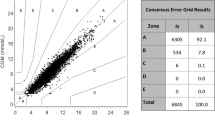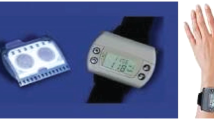Abstract
Conventional glucometer systems for plasma/blood glucose monitoring are based on colorimetry or static electrochemistry using a fixed input signal. The recent glucometer Linus, Wellion, Agamatrix, USA, based on wavesense dynamic electrochemistry, uses a time-varying input signal to give a more accurate glucose reading. The purpose of this study was to compare the plasma glucose (PG) readings obtained by nursing staff from glucometer Linus and PG values estimated on an approved analyzer Daytona™, Randox, Global Medical Instrumentation, Inc., MN, USA. In the course of 5 weeks, 221 fingerprick capillary blood samples were taken from persons with diabetes at different times and investigated using glucometer Linus. Within two following minutes, blood from the same fingerprick was also collected in a tube and centrifuged; the plasma was analyzed on the Daytona™ analyzer. Statistical analysis was performed using the software SPSS v. 15.0, SPSS Inc., Chicago, IL, USA. A total of 221 paired PG values were plotted on the error grid diagram indicating that 218 values (98.6%) of the glucose readings (Linus vs. Daytona) were within the clinically accurate zone A (maximum difference ±20%) and 3 values (1.4%) within the acceptable zone B. Daytona showed 4 PG values <4.2 mmol/l (75 mg/dl) and their difference of respective Linus readings was always <0.83 mmol/l (15 mg/dl). Correlation of results was strong (r = 0.992). Glucometer Linus readings correspond to the ISO and FDA standards. So, Linus appears to be an accurate device for PG-self-monitoring and clinical practice.

Similar content being viewed by others
Abbreviations
- ADA:
-
American Diabetes Association
- CV:
-
Coefficient of variation
- FDA:
-
Food and Drug Administration
- ISO:
-
International Organization for Standardization
- PG:
-
Plasma glucose concentration
- PWD:
-
Person with diabetes
- SMBG:
-
Self-monitoring of blood glucose concentration
- SMPG:
-
Self-monitoring of plasma glucose concentration
References
The Diabetes Control Complications Trial Research Group (1993) The effect of intensive treatment of diabetes on the development, progression of long-term complications in insulin-dependent diabetes mellitus. N Engl J Med 329:977–986
Monnier L, Colette C, Lapinski H, Boniface H (2004) Self-monitoring of blood glucose in diabetic patients: from the least common denominator to the greatest common multiple. Diabetes Metab 30:113–119
Bergenstal RM, Gavin JR (2005) Global consensus conference on glucose monitoring panel: the role of self-monitoring of blood glucose in the care of people with diabetes: report of a global consensus conference. Am J Med 118(Suppl):1S–6S
Davidson J (2005) Strategies for improving glycemic control: effective use of glucose monitoring. Am J Med 118(Suppl):27S–32S
Blonde L, Karter AJ (2005) Current evidence regarding the value of self-monitored blood glucose testing. Am J Med 118(Suppl):20S–26S
AACE Diabetes Mellitus Clinical Practice Guidelines Task Force (2007) American Association of Clinical Endocrinologists medical guidelines for clinical practice for the management of diabetes mellitus. Endocr Pract 13(Suppl 1):4–68
McAndrew L, Schneider SH, Burns E, Leventhal H (2007) Does patient blood glucose monitoring improve diabetes control? a systematic review of the literature. Diabetes Educ 33:991–1011
American Diabetes Association (2008) Standards of medical care in diabetes—2008. Diabetes Care 31(Suppl):S12–S54
Garg SK (2008) Glucose monitoring: an important tool for improving glucose control and reducing glycemia. Diabetes Technol Ther 10(Suppl 1):S-1–S-4
Nielsen JK, Chrinstiansen JS (2008) Self-monitoring of blood glucose–epidemiological and practical aspects. Diab Tech Therap 10(Suppl 1):35–42
Schutt M, Kern W, Krause U, Busch P, Dapp A, Grziwotz R, Mayer I, Rosenbauer J, Wagner C, Zimmermann A, Kerner W, Holl RW (2006) DPV Initiative: is the frequency of selfmonitoring of blood glucose related to long-term metabolic control? Multicenter analysis including 24 500 patients from 191 centers in Germany and Austria. Exp Clin Endocrinol Diabetes 114:384–388
Mahoney JJ, Ellison JM (2007) Assessing glucose monitoring performance—a standardized approach. Diabetes Technol Ther 9:545–552
Atkins RC, Zimmet P (2010) Diabetic kidney disease: act now or pay later. Acta Diabetol 47:1–4
Giugliano D, Standl E, Vilsbøll T, Betteridge J, Bonadonna R, Campbell IW, Schernthaner GH, Staels B, Trichopoulou A, Farinaro E (2009) Is the current therapeutic armamentarium in diabetes enough to control the epidemic and its consequences? What are the current shortcomings? Acta Diabetol 46:173–181
Colino E, Álvarez MA, Carcavilla A, Alonso M, Ros P, Barrio R (2010) Insulin dose adjustment when changing from multiple daily injections to continuous subcutaneous insulin infusion in the pediatric age group. Acta Diabetologica, Published online. doi: 10.1007/s00592-009-0103-x
Giménez M, Lara M, Jiménez A, Conget I (2009) Glycaemic profile characteristics and frequency of impaired awareness of hypoglycaemia in subjects with T1D and repeated hypoglycaemic events. Acta Diabetol 46(4):291–293. doi:10.1007/s00592-008-0085-0
ISO 15197:2003-05-01 (2003) In Vitro Diagnostic Test Systems. Requirements for Blood-Glucose Monitoring System for Self-Testing in Managing Diabetes Mellitus. Reference Number ISO 15197:2003 (E). Geneva: International Organization for Standardization, 2003. http://www.iso.org
U.S. Food and Drug Administration, Division of Clinical Laboratory Devices (1998) Review criteria for assessment of portable invasive blood glucose monitoring in vitro diagnostic devices which use glucose oxidase, dehydrogenase, or hexokinase methodology. Rockville, MD: Food and Drug Administration, 1998
Oberg D, Ostenson C (2005) Performance of glucose dehydrogenase- and glucose oxidase-based blood glucose meters at high altitude and low temperature [letter]. Diabetes Care 28:1261
Haller MJ, Shuster JJ, Schatz D, Melker RJ (2007) Adverse impact of temperature and humidity on blood glucose monitoring reliability. Diabetes Technol Ther 9:1–9
Fink KS, Christensen DB, Ellsworth A (2002) Effect of high altitude on blood glucose meter performance. Diabetes Technol Ther 4:627–635
Tang Z, Lee JH, Louie RF, Kost GJ (2000) Effects of different hematocrit levels on glucose measurements with handheld meters for point-of-care testing. Arch Pathol Lab Med 124:1135–1140
Tang Z, Du X, Louie RF, Kost GJ (2000) Effects of drugs on glucose measurement with handheld glucose meters and a portable glucose analyzer. Am J Clin Pathol 113:75–86
Skeie S, Thue G, Nerhus K, Sandberg S (2002) Instruments for self-monitoring of blood glucose: comparisons of testing quality achieved by patients and a technician. Clin Chem 48:994–1003
Melker RJ (2003) Test strips for blood glucose monitors are not always accurate [letter]. Diabetes Care 26:3190
Hönes J, Müller P, Surridge N (2008) The technology behind glucose meters: test strips. Diab Tech Therap 10(Suppl 1):10–26
Iyengar S, Wiley M, Nadeau D (2007) Performance of the Wavesense–enabled glucose monitoring system across multiple lots. Diab Stoffw Herz 1:15–20
Wendisch U, Wiley M, Carnevale E, Weissenbacher S (2009) Wellion Linus selfmonitoring of blood glucose–performance in an outpatient clinic. 2nd International Conference on Advanced Technologies & Treatments for Diabetes (ATTD 2009), February 25–28, 2009, Athens, Greece. http://www2.kenes.com/attd2009/Pages/home.aspx
Hirsch IB, Bode BW, Childs BP, Close KL, Fischer WA, Gavin JR, Ginsberg BH, ChH Raine, Verderese CA (2008) Self-Monitoring of Blood Glucose (SMBG) on insulin- and non-insulin-using adults with diabetes: consensus recommendation for improving SMBG accuracy, utilization, and research. Diab Tech Therap 10(8):419–440
American Diabetes Association (2008) 2008 resource guide: blood glucose monitoring and data management systems. Diabetes Forecast 61:RG31–RG32, RG34–RG48
Chlup R, Payne M, Zapletalova J, Komenda S, Doubravova B, Reznickova M, Chlupova L, Seckar P (2005) Results of selfmonitoring on glucometer systems Advance and Optium in daily routine. Biomed Pap Med Fac Univ Palacky Olomouc Czech Repub. 149(1):127–139
Klonoff DC (2010) Regulatory controversies surround blood glucose monitoring devices. J Diabetes Sci Technol 4(2):231–235
Kirk JK, Stegner JS (2010) Self-monitoring of blood glucose: practical aspects. J Diabetes Sci Technol 4(2):435–439
Pinkos AF (2010) FDA meeting: clinical accuracy requirements for point of care blood glucose meters. J Diabetes Sci Technol 4(2):496
D’Orazio P (2003) Biosensors in clinical chemistry. Clin Chim Acta 334:41–69
Heinemann L, Koschinsky T (2008) Clinical application and challenges of blood glucose measurement technology for selfmonitoring. Diabetes Technol Ther 10(Suppl 1):S27–S34
Bergenstal R, Pearson J, Cembrowski GS, Bina D, Davidson J, List S (2000) Identifying variables associated with inaccurate self-monitoring of blood glucose: proposed guidelines to improve accuracy. Diabetes Educ 26:981–989
Clarke WL, Cox D, Gonder-Frederick LA, Carter W, Pohl SL (1987) Evaluating clinical accuracy of systems for self-monitoring of blood glucose. Diabetes Care 10:622–628
Parkes JL, Pardo S, Slatin SL, Ginsburg BH (2000) A new consensus error grid to evaluate the clinical significance of inaccuracies in the measurement of blood glucose. Diabetes Care 23(8):1143–1148
Peterson K, Zapletalova J, Kudlova P, Matuskova V, Bartek J, Novotny D, Chlup R (2009) Benefits of three-month continuous glucose monitoring for persons with diabetes using insulin pumps and sensors. Biomed Pap Med Fac Univ Palacky Olomouc Czech Repub 153(1):47–52
Chlup R, Zapletalova J, Peterson K, Poljakova I, Lenhartova E, Tancred A, Perera R, Smital J (2009) Impact of buccal glucose spray, liquid sugars and dextrose tablets on the evolution of plasma glucose concentration in healthy persons. Biomed Pap Med Fac Univ Palacky Olomouc Czech Repub 153(3):205–209
Rao A, Iyengar S, Wiley M, Mallery E (2009) Wavesense algorithms account for hematocrit variations while determining blood glucose. Diabetologia 52(Suppl 1):S366 (Abstract)
Rao A, Wiley M, Iyengar S, Nadeau D, Carnevale J (2010) Individuals achieve more accurate results with meters that are codeless and employ dynamic electrochemistry. J Diabetes Sci Technol 4(1):145–150
American Diabetes Association (2002) Report of the committees on the diagnosis, classification of diabetes mellitus. Diabetes Care 25(Suppl 1):S6–S20
American Diabetes Association (2003) Clinical practice recommendations. Diabetes Care 36(Suppl 1):S1–S56
Kristensen GBB, Nerhus K, Thue G, Sandbeerg S (2006) Results and feasibility of an external quality assessment scheme for selfmonitoring of blood glucose. Clin Chem 52:1311–1317
Poolsup N, Sukcomboon N, Jiamsathit W (2008) Systematic review of the benefits of self-monitoring of blood glucose on glycemic control in type 2 diabetes patients. Diab Tech Therap 10(Suppl 1):51–66
Conflict of interest
The authors have nothing to declare.
Author information
Authors and Affiliations
Corresponding author
Rights and permissions
About this article
Cite this article
Chlup, R., Doubravova, B., Peterson, K. et al. Wavesense technology glucometer Linus for routine self-monitoring and clinical practice. Acta Diabetol 48, 35–40 (2011). https://doi.org/10.1007/s00592-010-0213-5
Received:
Accepted:
Published:
Issue Date:
DOI: https://doi.org/10.1007/s00592-010-0213-5




